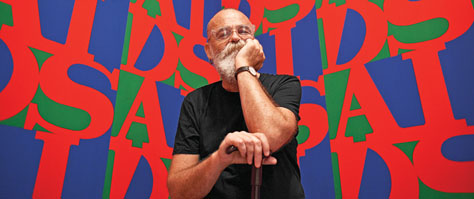
Photograph by Jessica Darmanin
How General Idea Predicted the Future
Three artists eerily foreshadowed modern phenomena like reality TV and Facebook.
—
Among the many reasons to celebrate this week’s centenary of media guru Marshall McLuhan’s birth is that he gave life to General Idea (GI), one of the world’s most subversive art practices. Next week, Haute Culture: General Idea, the first comprehensive retrospective of the three-man Canadian cultural collective, opens at the Art Gallery of Ontario. It’s the 25-year-long story of A.A. Bronson, Felix Partz, and Jorge Zontal, who came together in 1969 as roommates in a Toronto house that had once been a store. “We were unemployed and bored,” says Bronson, 65, explaining how the group began their art career by dreaming up fictitious retail identities for their home’s large storefront window. “One day we turned the place into a romance bookshop with boxes of Harlequins we found in the trash. The door to the house was always locked and there was always a sign that said ‘Back in 5 minutes.’ ”
Quickly the three earned a reputation as a gang that was redefining the role of the artist. “For GI, he was no longer someone who made things to hang on walls,” says Frédéric Bonnet, Haute Culture’s curator, “but a commentator on society.” They attended parties in matching outfits, obsessively documented themselves as real and fictionalized characters, and lived together as a threesome. “They introduced the idea that a relationship can be a triangle,” Bonnet says, “and not just a couple with two kids.”
The group chose the name “General Idea” to describe their practice, which was media omnivorous and favoured intellect over technical virtuosity. GI demonstrated this to the world in 1971, when they staged the Miss General Idea Beauty Pageant at the Art Gallery of Ontario, where contestants were both men and women. With this piece of online casino performance art, Bronson, Partz, and Zontal imitated popular culture to plug themselves into one of the most important dialogues of the day: the questioning of gender stereotypes.
“It was the era of McLuhan,” says Bronson, explaining how GI used every available form of mass communication—including TV, mail, balloons, and contests—to create art they could spread “like a media virus.” Soon, the group was more conscious of how its work was “presented through media than through exhibitions.”
Another McLuhan-inspired tactic was Bronson, Partz, and Zontal’s refusal to apply an individual signature to any of their works. Like their spiritual godfather, GI believed the future of art lay in collaboration, appropriation, and subversion. GI’s approach wasn’t for everyone. As with McLuhan, the group was often described as jokesters making impenetrable puns.
All this changed when AIDS hit the world and Partz and Zontal found out they had it (both died in 1994 of causes related to the disease). As Haute Culture masterfully documents, General Idea’s output from 1987 onward became exclusively focused on bringing attention to AIDS. Until the mid ’80s it was known as “gay cancer,” Bonnet explains. “GI was the first to market the disease.”
Bronson, Partz, and Zontal did this by appropriating the world-recognized design of American artist Robert Indiana’s 1964 love logo, substituting the word “love” with “AIDS” and reproducing this image on stamps, wallpaper, screen savers, posters, T-shirts, and as a sculpture. “They hijacked Indiana’s icon,” says Bonnet. It was a move that placed GI in the forefront of the world’s cultural zeitgeist. At the height of AIDS, Bronson, Partz, and Zontal’s message that art could be infectious was eerily apt.
Yet GI’s influence was far from over. Like McLuhan, the collective’s prescience becomes increasingly apparent with the passage of time. According to Bonnet, today the Miss General Idea Pageant appears a lot like reality TV, GI’s focus on self-documentation foreshadows Facebook, and the group’s belief in the end of the individual signature has come to pass on websites like Wikipedia. Offering a final comment on GI’s role in art history, Bonnet adds, “Now it’s so common for an artist to have a diverse practice—to make clothes, to make sculpture, to make film. But then it wasn’t and General Idea was doing all these things. They did everything.”